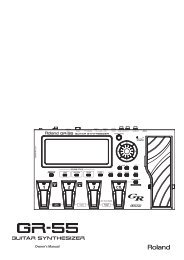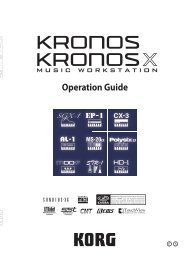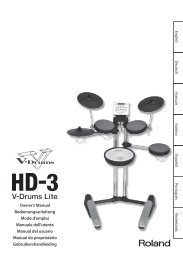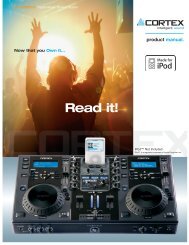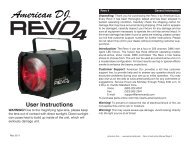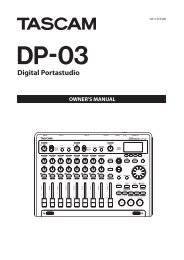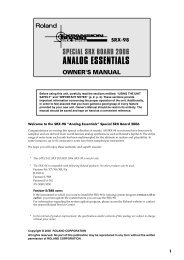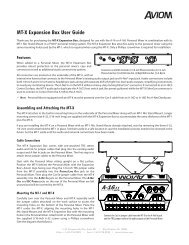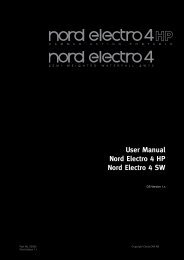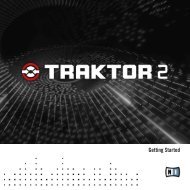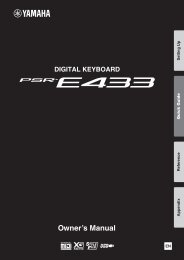Korg Microkorg Owner's Manual - zZounds.com
Korg Microkorg Owner's Manual - zZounds.com
Korg Microkorg Owner's Manual - zZounds.com
You also want an ePaper? Increase the reach of your titles
YUMPU automatically turns print PDFs into web optimized ePapers that Google loves.
MIDI on the microKORG<br />
Connecting an external MIDI sequencer or <strong>com</strong>puter etc.<br />
You can play the microKORG's keyboard and record your performance on an<br />
external MIDI sequencer/<strong>com</strong>puter (connected via a MIDI interface), and then play<br />
back the recorded performance to sound the microKORG's tone generator (i.e.,<br />
using the microKORG as an input keyboard and MIDI tone generator). To do this,<br />
connect the MIDI OUT and MIDI IN connectors of the microKORG and your<br />
external MIDI sequencer/<strong>com</strong>puter to each other.<br />
Some USB-MIDI interface devices may not be able to transmit/receive the<br />
microKORG's MIDI exclusive messages.<br />
<strong>com</strong>puter<br />
MIDI interface<br />
microKORG<br />
MIDI OUT<br />
MIDI IN<br />
MIDI OUT<br />
MIDI IN<br />
○ ○ ○ ○ ○ ○ ○ ○ ○ ○ ○ ○ ○ ○ ○ ○ ○ ○ ○ ○ ○ ○ ○ ○ ○ ○ ○ ○ ○ ○ ○ ○ ○ ○ ○ ○ ○<br />
○<br />
MIDI-related settings<br />
MIDI channel setting<br />
In order to exchange data with a connected external MIDI device, you must set the<br />
microKORG's MIDI channel to match the MIDI channel of the external MIDI<br />
device.<br />
1 Set the MIDI channel of the microKORG.<br />
Set the EDIT SELECT 2 dial to the MIDI position, and use knob 1 ("MIDI CH")<br />
to set the MIDI channel. (➝p.51)<br />
2 Set the MIDI channel of the connected external MIDI device.<br />
(➝For information on setting the MIDI channel of the external MIDI device,<br />
refer to the owner's manual of that device.)<br />
GLOBAL "POSITION" setting<br />
The microKORG's GLOBAL "POSITION" lets you specify how MIDI IN/OUT will<br />
be internally routed. This will affect how the MIDI data will be affected by the<br />
"MASTER TRANSPOSE," "VELOCITY CURVE," OCTAVE SHIFT, and arpeggiator<br />
settings. (➝p.47)<br />
• Normally when controlling an external MIDI tone generator from the<br />
microKORG, you will set "POSITION" to Post KBD ( ). The various settings<br />
listed above will affect the MIDI data that is transmitted.<br />
The received data will be processed as "MASTER TRANSPOSE": 0, "VELOCITY<br />
CURVE": Curve ( ), and OCTAVE SHIFT: 0.<br />
• Normally when controlling the microKORG's tone generator from an external<br />
MIDI device, you will set "POSITION" to Pre TG ( ). The various settings<br />
listed above will affect the MIDI data that is received (with the exception of<br />
"OCTAVE SHIFT," which will be processed as 0).<br />
The transmitted data will be processed as "MASTER TRANSPOSE": 0 and<br />
"VELOCITY CURVE": Curve ( ).<br />
SHIFT function "MIDI FILTER" settings<br />
You can specify whether program change, pitch bend, control change, and system<br />
exclusive messages will be transmitted or received. (➝p.60)<br />
SHIFT function "CONTROL CHANGE" settings<br />
You can assign control change numbers to the major parameters that affect the<br />
sound, and use an external MIDI device to perform the same operations as when<br />
the knobs and keys of the microKORG are operated. Conversely, you can operate<br />
the microKORG's knobs and keys to control an external MIDI device. (➝p.61)<br />
MIDI "LOCAL" setting when connecting an external MIDI<br />
sequencer or <strong>com</strong>puter<br />
If notes are sounding doubled when the microKORG is connected to an external<br />
MIDI sequencer or <strong>com</strong>puter, turn the Local setting off (MIDI "LOCAL" OFF).<br />
(➝p.51)<br />
If the microKORG is connected to an external MIDI sequencer or <strong>com</strong>puter, and the<br />
Echo Back setting of the external MIDI sequencer or <strong>com</strong>puter is turned on while<br />
the microKORG's Local Control setting is also on, the performance data generated<br />
when you play the microKORG's keyboard will be sent to the external MIDI<br />
sequencer, and will also be echoed-back to sound the microKORG's tone generator<br />
49



